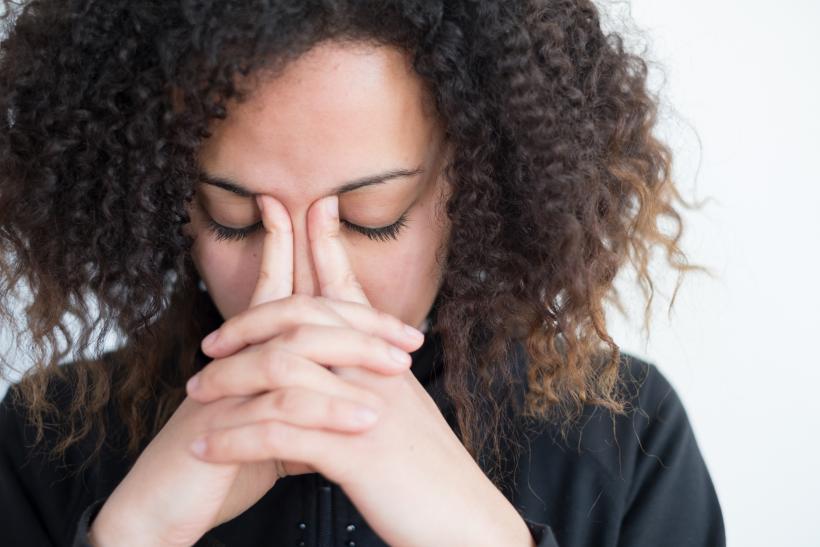
I’m not going to sugar coat sex injuries, like a bruised cervix, for you — they hurt.
Sex injuries are going to happen if you’re a sexually active person — and I’m not necessarily talking about a fractured penis or lost sex toy. Less extreme incidents can occur during intercourse, and it’s not all that surprising if you think about the precarious nature of sex: two different bodies performing two different actions while being two different sizes.
I’m not going to sugar coat sex injuries for you — they hurt.
While scrolling through Twitter, I stopped at a tweet where a user was bragging about bruising his girlfriend's cervix, as if her pain was a compliment to his size. I soon realized that the science behind a bruised cervix is largely unknown and misunderstood.
For many years, I didn’t know what was causing my cervical cramping and pain after penis in vagina (PIV) intercourse. The pain became so damaging that it triggered vaginismus, an involuntary muscle spasm where the muscles contract to prevent penetration of any sort (fingers, tampons, penis, etc.). While cervical bruising does not contribute to long-term damage, it can influence other issues. Bruising a cervix is the furthest thing from a compliment — it’s synonymous with pain and equates sex with pain.
1. What Is A Cervix?
The cervix is a cylinder-shaped opening between the uterus and vaginal canal. It is made up of fibromuscular tissue and has two main parts: the part of the cervix that can be seen during an exam and the tunnel through the cervix into the uterus.
The cervix is also affected by birth control, ovulation, and menstruation. Hormonal birth control causes the cervix to move, ovulation makes the cervix higher and softer in the canal, and when you’re menstruating, the cervix is lower and harder.
Just like a penis, when someone is aroused, the cervix enlarges and becomes softer and higher (around two to three inches higher). When sexually stimulated, the overall vagina can expand 200%. When someone with a cervix is not aroused, it is lower and harder. So when an individual isn’t as turned on, a penis can bruise the cervix more easily while in the vagina because of the hardness and lower position. This can be why certain positions cause discomfort one day but vary the next day. The cervix moves around a lot. It even changes throughout the cycle of one day.
Penis size can contribute to the bruising. Dr. Catherine Hansen, an OBGYN, wellness leader, speaker, and educator explains that “most physicians don’t necessarily call it ‘bruising,’ but it can create a sense of deep pressure.” If someone isn’t turned on enough and their partner is well-endowed, the thrusting motion can bump the cervix and cause cramping and pain during or after intercourse.
2. What Does A Bruised Cervix Feel Like?
Most people will feel cramping after intercourse, but some people feel it during sex, as if your partner is hitting a very painful wall. Tenderness in the lower abdomen 12 to 48 hours after intercourse is typically a sign of a bruised cervix. The pain may subside within a day or take about a week. Bleeding or spotting when you aren’t on your period could indicate cervical bruising. If the bleeding is heavy, seek out a medical professional.
You Might Also Like: Confidence In The Bedroom Boils Down To One Thing
Immediate pain during intercourse can occur because the cervix is already sensitive and is being irritated during certain positions. Cramping after bruising is very common and leaves the uterus unhappy. The cramps feel similar to menstrual cramps and can be treated with over the counter medication.
A bruised cervix is most common with people who have a tipped uterus that goes back towards the tailbone. This means that the cervix is pointing up during sex and is probably doing to get a little bumped.
3. How Can You Avoid Cervical Pain?
Foreplay (about 20 to 30 minutes of it) is the number one key to avoiding cervical bruising, as it gears the body up for arousal. If someone is not aroused, they may not have much natural lubrication, which can contribute to a plethora of other sex injuries like tearing from dryness.
Dr. Hansen explains that for some people the cervix may sit “closer to the lower part of the vagina.” And as aforementioned, not all couples are going to fit together like a puzzle piece. Different sex positions should be up for experimentation. If you’re prone to experiencing cervical bruising or pain, incorporate more shallow penetration positions.
Being on top is a great way to control your movements and thrusting to prevent any further injury. Spooning is another great position where both partners are lying on their sides. Missionary but with your legs wrapped around your partners' legs instead of on their shoulders or behind your ears. Standing up and having sex is another way to avoid any deep penetration issues.
Dr. Hansen says that being in tune with your body is very important during sex or masturbation. She says to “reposition or stop if there is pelvic pressure or pain during sex so that any ongoing pain would be completely avoided.”
There are other ways to climax as well. Sex doesn’t have to involve PIV intercourse for hetero couples. Handwork, oral, foreplay, and anal are all other amazing ways to achieve an orgasm.
4. How Do You Treat Cervical Pain?
To ease cervical pain, Dr. Hansen notes how “ibuprofen 400-800mg can help with the cramping. For women who anticipate that they will have pain, they can take the ibuprofen dose prior to intercourse (approximately 30 minutes prior to sex would be best).”
The good news is that cervical bruising is not permanent. “Any pelvic pressure or pain that results from cervical ‘trauma’ (tapping or touching the cervix during sex) is temporary and should be resolved with a couple of hours (max 24 hours),” reassures Dr. Hansen.
Lastly, if you have an IUD and have been experiencing cervical pain after it was inserted, visit your doctor to make sure it hasn’t moved.
I have found that to avoid cervical bruising, I need to be largely in control of the situation. Experimenting with positions has increased my ability to avoid any discomfort or pain with my partner. Also, encouraging satisfying foreplay can help you avoid this very common but ignored sex injury.








